VERY RARE! WWII "CONFIDENTIAL" 1944 USS Intrepid CV-11 Kamikaze Attack Type 1 Photograph (KAMIKAZE PLANE ON DECK)


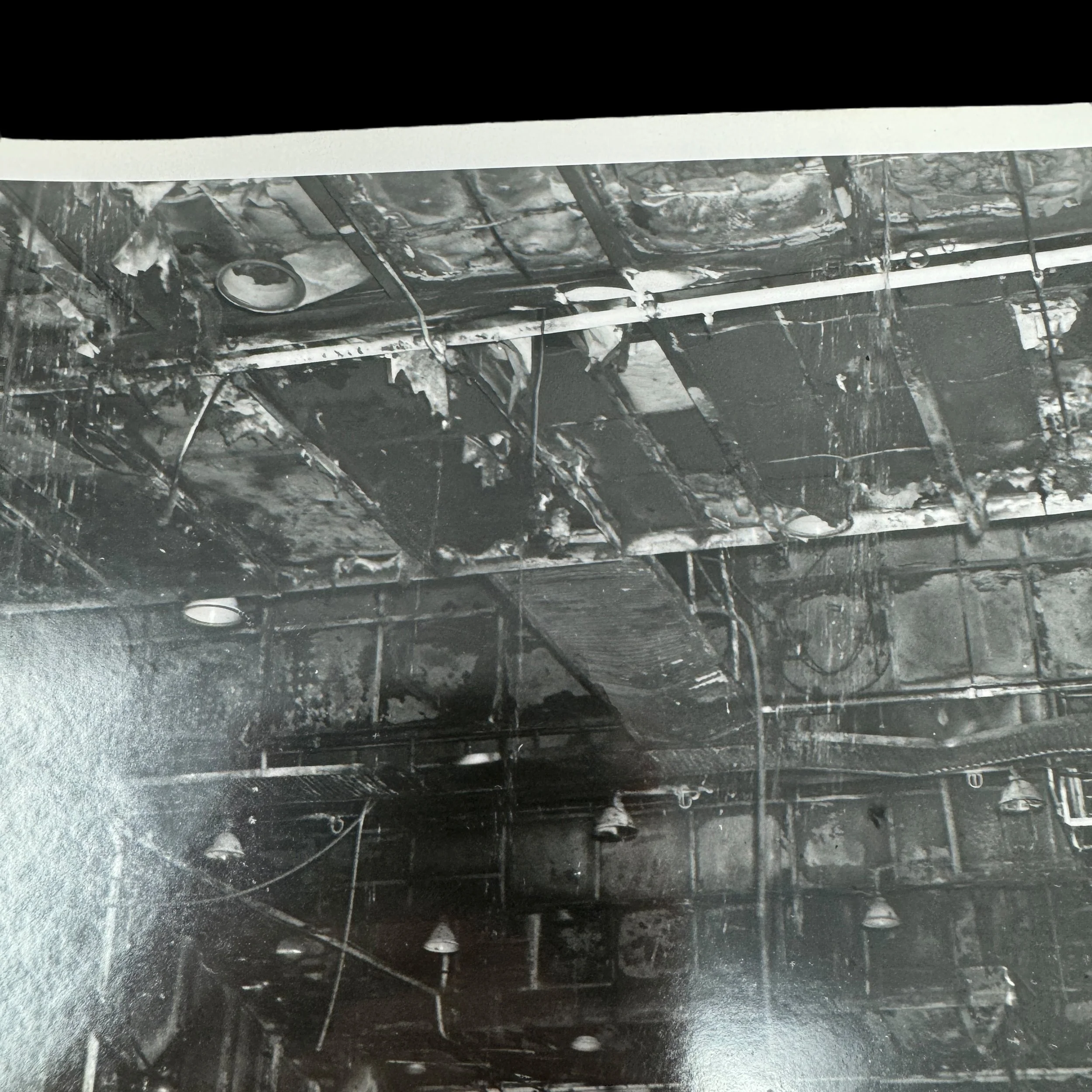
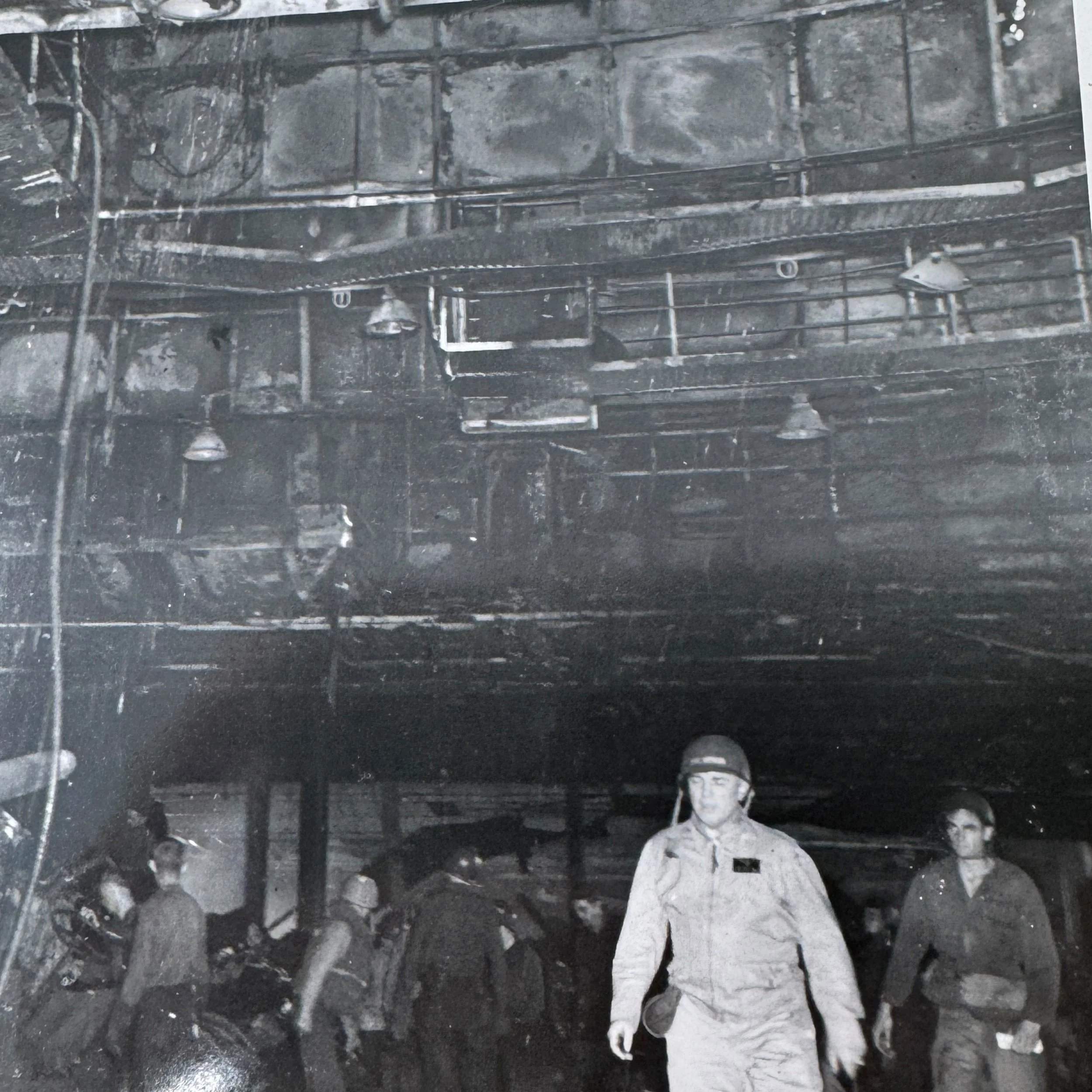


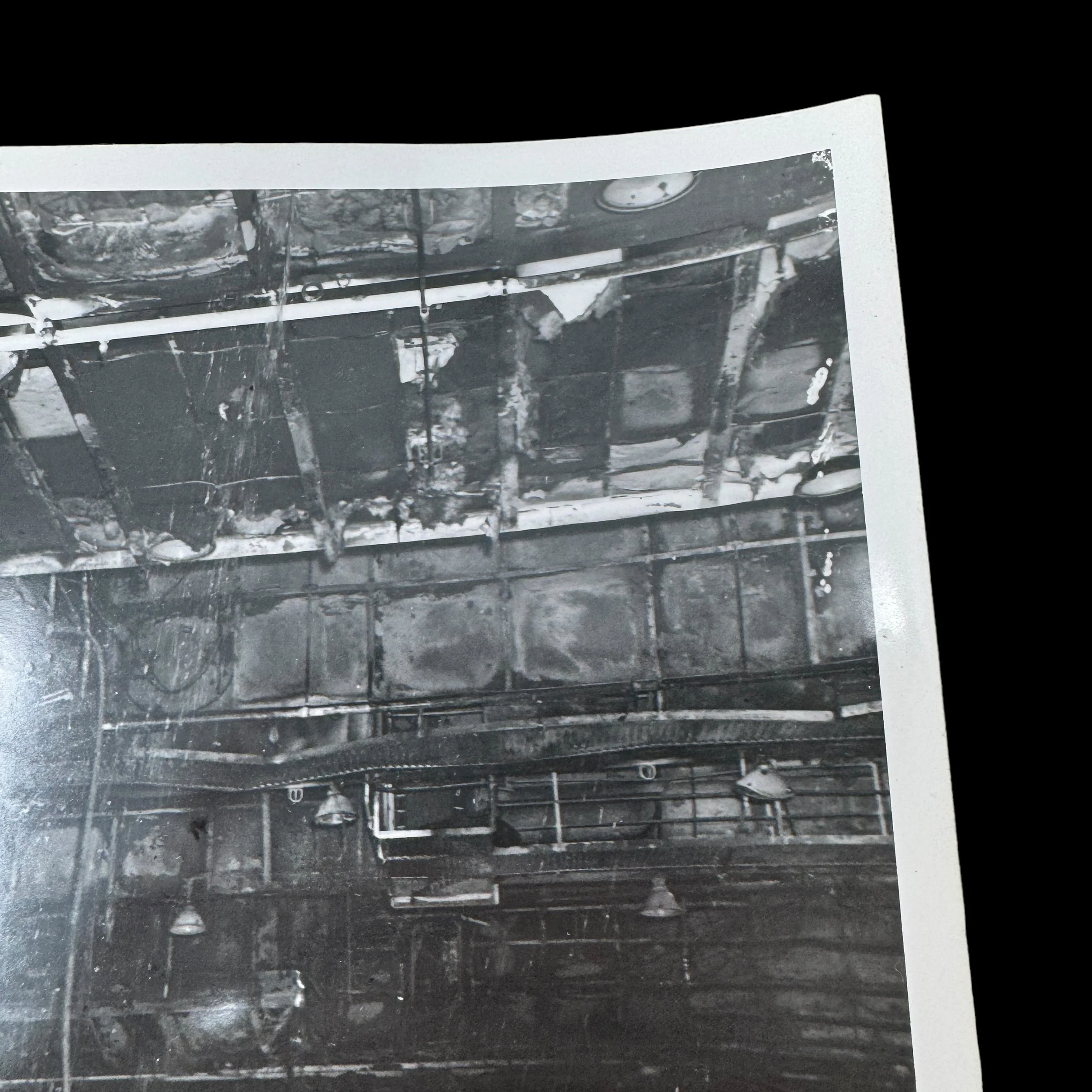
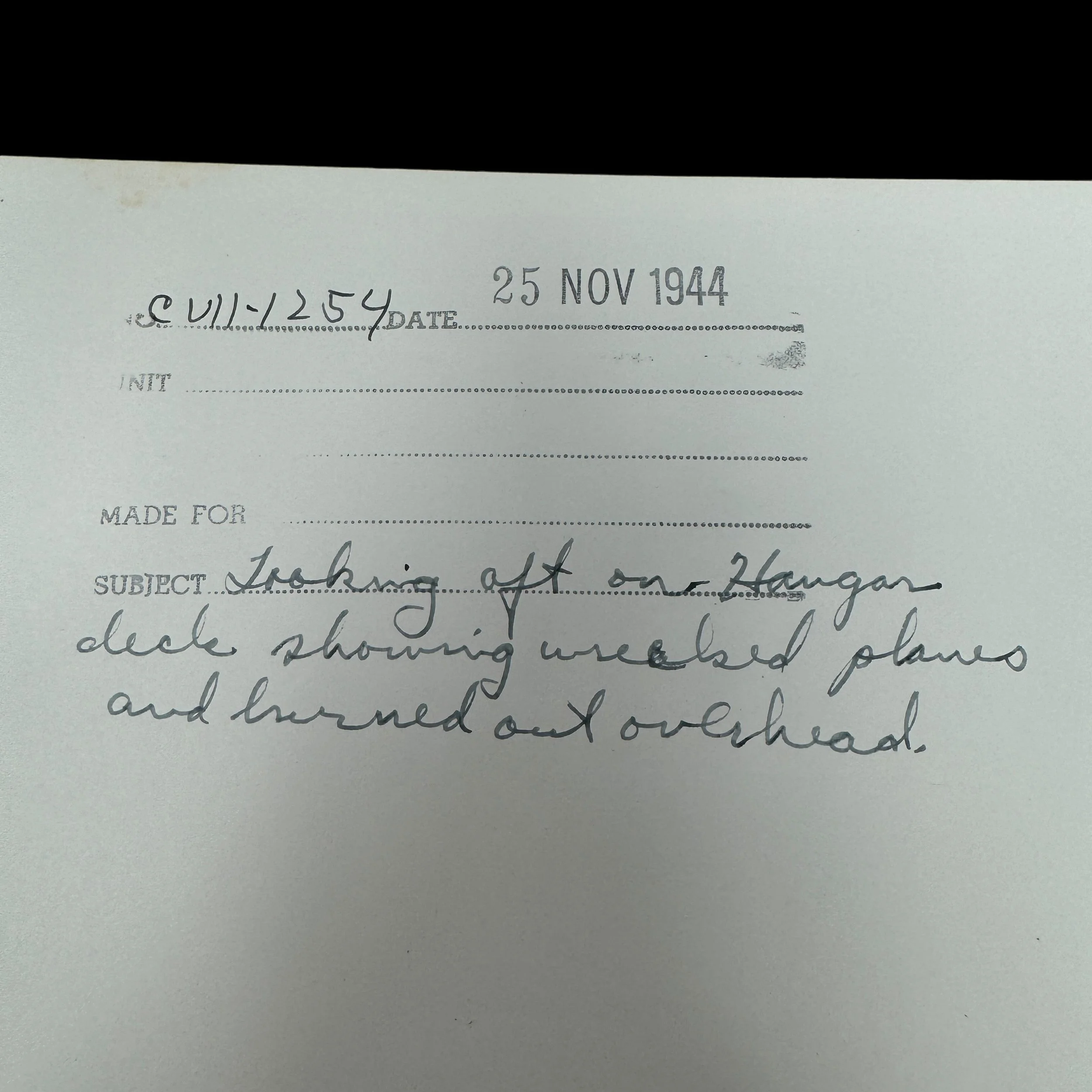
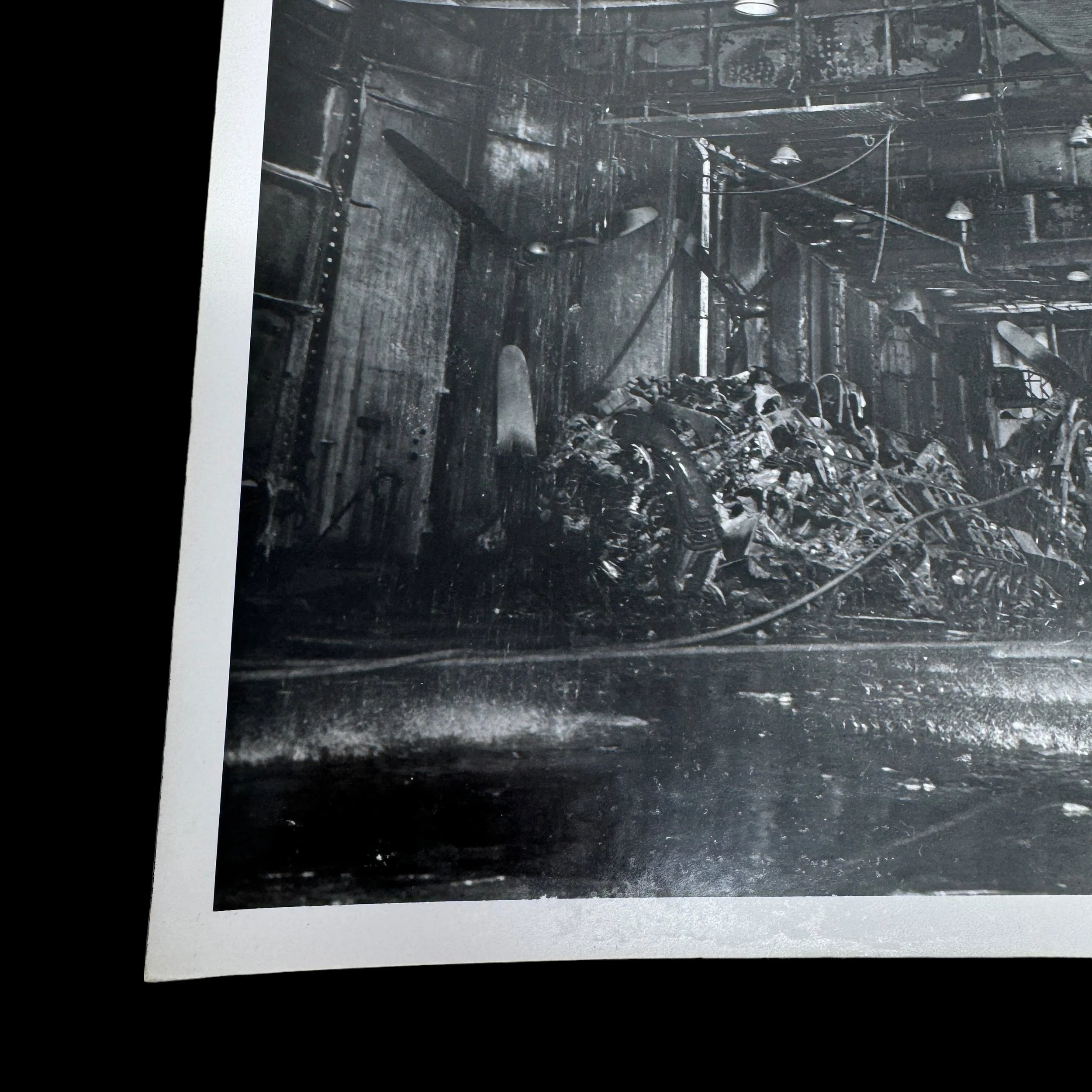
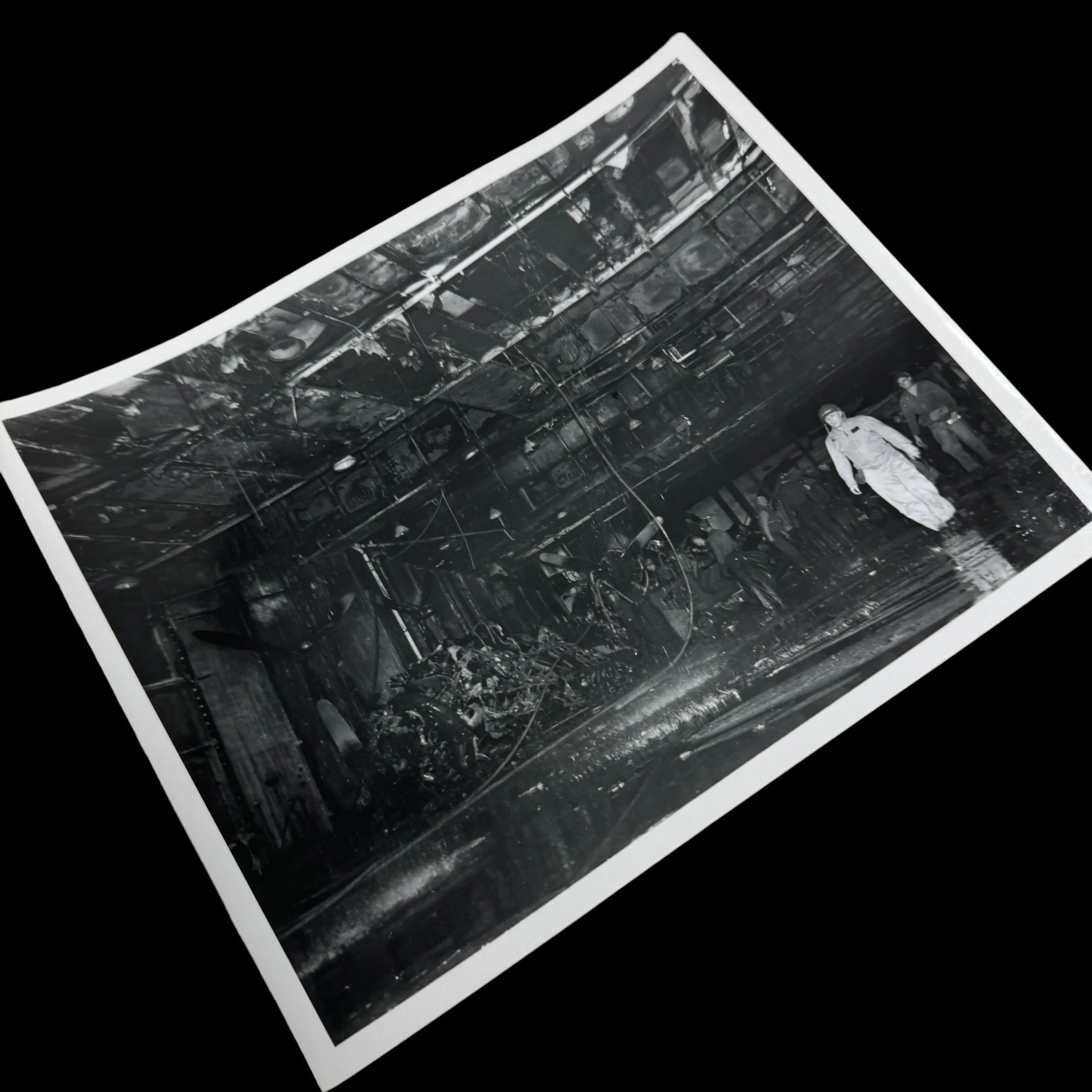
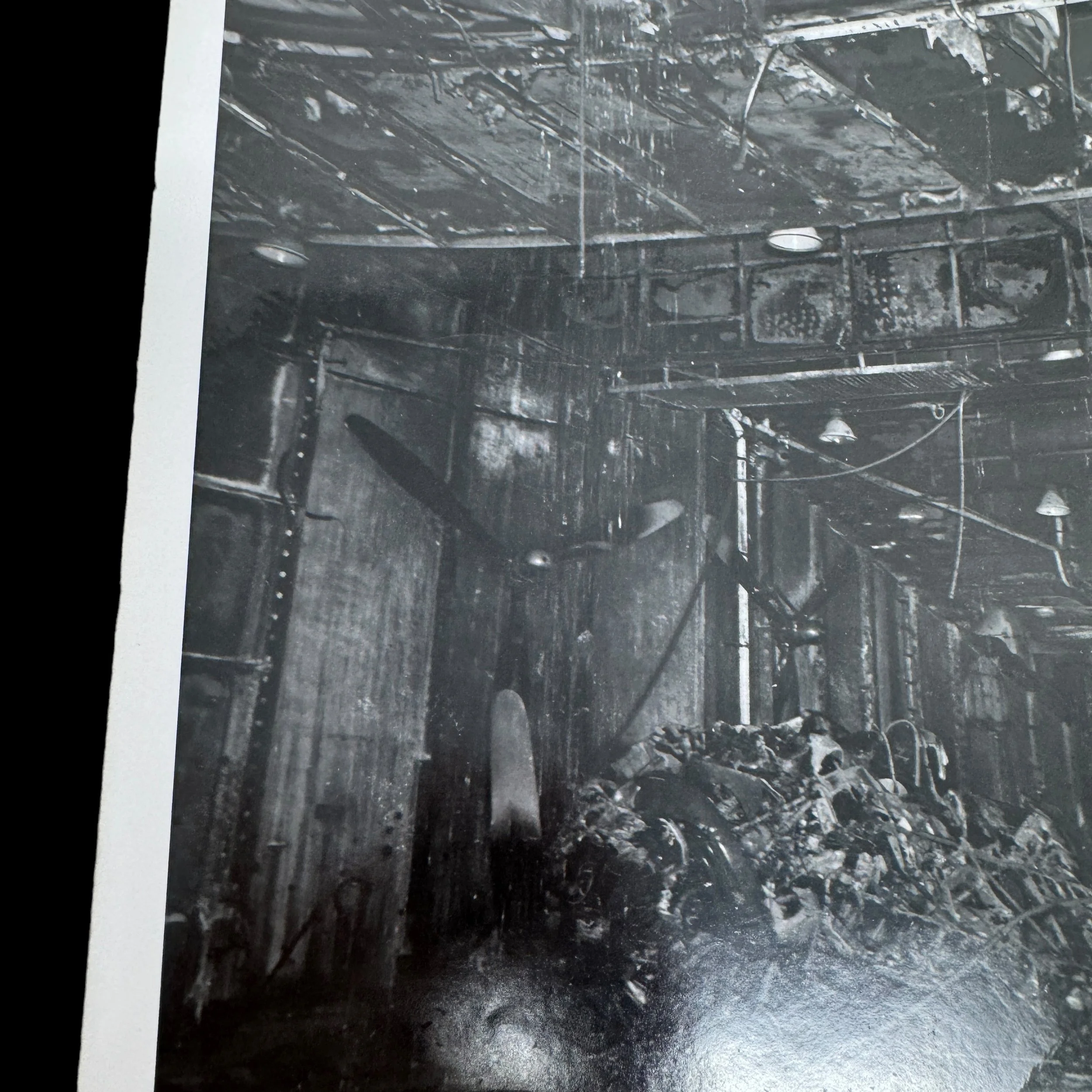
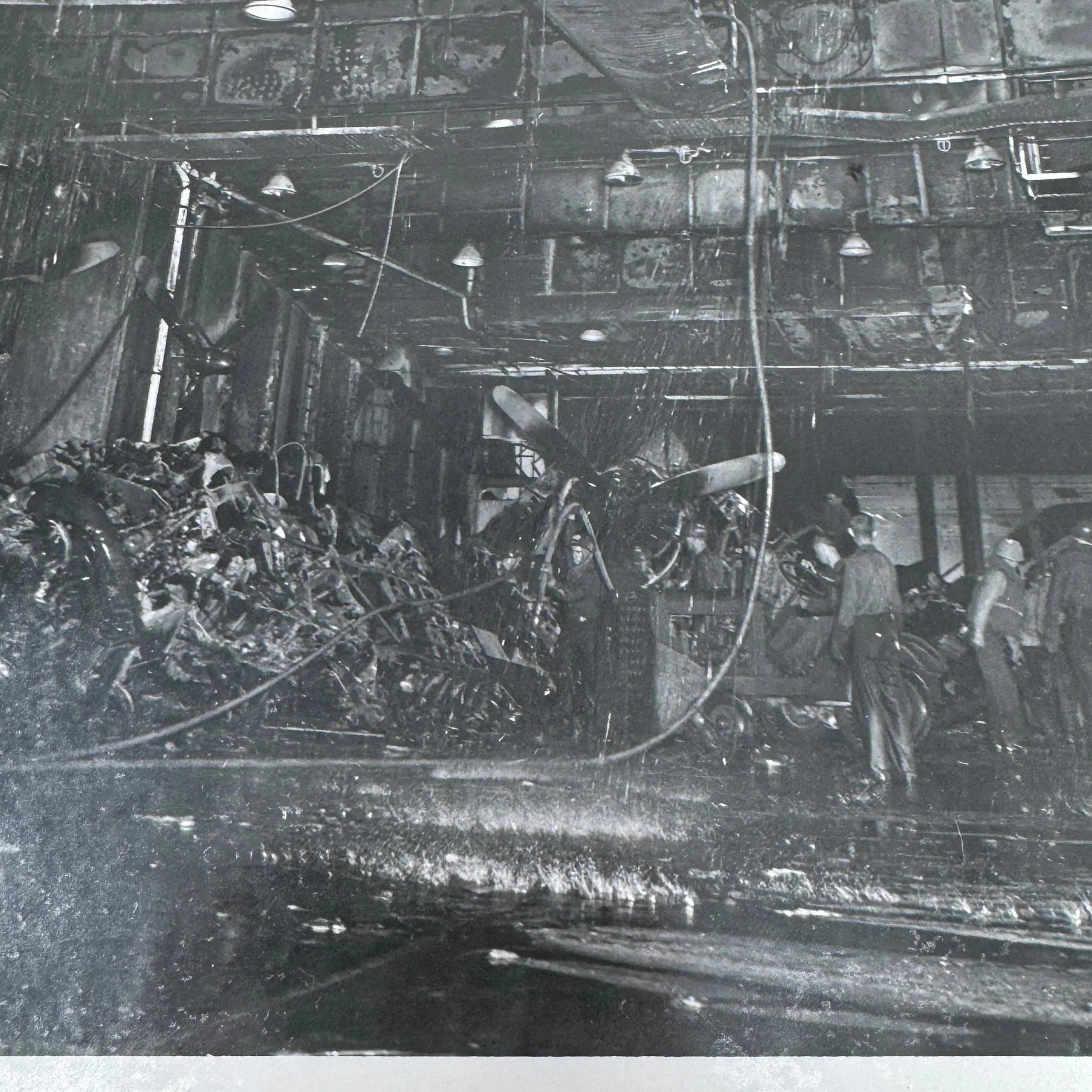

VERY RARE! WWII "CONFIDENTIAL" 1944 USS Intrepid CV-11 Kamikaze Attack Type 1 Photograph (KAMIKAZE PLANE ON DECK)
Comes with a hand-signed C.O.A.
*UNSEEN/UNRELEASED DAMAGE ASSESSMENT PHOTOGRAPH OF THE USS INTREPID CV-11 FOLLOWING THE JAPANESE KAMIKAZE ATTACK.
1 OF 1
Size: 8 x 10 inches
World War II Original Photograph - TYPE 1
Dated: November 26th, 1944
Subject: CV-11 USS Intrepid Aircraft Carrier
Marked: “CONFIDENTIAL” (MILITARY INTELLIGENCE) Chief of the Bureau of Aeronautics
*THIS TYPE 1 WWII PHOTOGRAPH STILL MAINTAINS THE NEAR-MINT CONDITION CONFIDENTIAL STAMPS AS WELL AS THE HAND-WRITTEN PHOTOGRAPHER INSCRIPTIONS OF THE DAMAGE, LOCATION, AND OTHER REMARKS TAKEN ON THE USS INTREPID CV-11
This extremely rare and museum-grade 1944 dated World War II Type 1 military intelligence combat damage photograph was taken aboard the USS Intrepid (CV-11) Essex-class aircraft carrier after taking severe damage from multiple Japanese kamikaze aircraft while operating off the of Philippines in the Pacific Theater.
On November 25, 1944, the USS Intrepid was engaged in operations off the coast of the Philippines as part of the U.S. Navy's campaign to liberate the archipelago from Japanese control. This period marked the intense and desperate final phase of the war, where Japan increasingly relied on kamikaze tactics—suicidal attacks by aircraft deliberately crashing into Allied ships.
On that fateful day, the Intrepid was struck by two Japanese kamikaze aircraft in rapid succession. The first plane hit the carrier near the ship’s starboard side, close to the island superstructure, causing a massive explosion and fire. Just minutes later, a second kamikaze crashed into the ship, adding to the devastation. The attacks killed 69 crew members and wounded over 100 others, making it one of the deadliest days for the Intrepid during the war.
What makes this “CONFIDENTIAL” marked Type 1 military intelligence photograph so rare is the realm of Type 1 photographs is that this is not a Type 1 press photograph, however, this is an even more rare Type 1 CONFIDENTIAL photograph of the WWII Chief of the Bureau of Aeronautics. As confidential documents, these images were of particular importance to the Chief of the Bureau of Aeronautics, the branch of the U.S. Navy responsible for the development, procurement, and support of naval aviation. These Type 1 photographs served as crucial intelligence photographs that were pivotal to U.S. operations in the Pacific Theater. This USS Intrepid (CV-11) Type 1 damage photograph of Japanese kamikaze damage would have been studied and examined by high-ranking officers and other military personnel.
The primary function of the photographs was to provide a detailed visual record of the damage sustained by the Intrepid. These images allowed naval engineers and architects to assess the extent of the destruction caused by the kamikaze strikes. Every aspect of the damage—ranging from the holes in the flight deck, the scorched areas around the superstructure, and the interior destruction—was meticulously documented. This documentation was crucial not only for the immediate repairs but also for understanding the vulnerabilities of the Essex-class carriers to such attacks.
For the Chief of the Bureau of Aeronautics, these photographs were indispensable in guiding decisions on how to enhance the design and construction of future carriers. The visual evidence provided insights into which areas of the ship required reinforcement, how damage control protocols could be improved, and what changes were necessary in the design of aircraft carrier defences. The Bureau used this information to adjust the production of new carriers and to retrofit existing ones with enhanced protection against similar attacks.
Beyond immediate damage assessment, the photographs served as a vital tool for strategic and tactical analysis. The Chief of the Bureau of Aeronautics, along with other senior naval officials, could analyze the effectiveness of Japanese kamikaze tactics by studying these images. Understanding the impact of the kamikaze attacks was essential for developing countermeasures. The photographs provided concrete evidence of the destructive potential of these kamikaee missions and influenced the development of new defensive strategies, such as the placement of anti-aircraft guns and the improvement of radar detection systems.
The Bureau of Aeronautics could also use the photographs to refine training programs for both aviators and ship crews. By studying the damage and how it was inflicted, naval planners could better prepare their forces to anticipate and mitigate similar threats in the future. The visual evidence also highlighted the importance of damage control training, ensuring that crews were better equipped to respond to attacks and minimize casualties and damage.
Full History of the USS Intrepid (CV-11):
The USS Intrepid (CV-11), an Essex-class aircraft carrier, was one of the most significant naval vessels in the United States Navy during World War II. Commissioned in August 1943, the Intrepid participated in several of the most crucial campaigns in the Pacific Theater, earning a distinguished reputation for its resilience and effectiveness in combat.
Commissioning and Early Operations
The USS Intrepid was commissioned on August 16, 1943, at Newport News, Virginia. As an Essex-class carrier, the Intrepid was part of a new generation of aircraft carriers that were larger, faster, and more heavily armed than their predecessors. Designed to project air power across vast ocean distances, the Essex-class carriers were instrumental in the U.S. Navy’s strategy of island hopping and establishing air superiority in the Pacific.
After a brief shakedown cruise and training in the Caribbean, the Intrepid transited the Panama Canal and joined the Pacific Fleet in January 1944. Its first assignment was to participate in Operation Flintlock, the campaign to capture the Marshall Islands from the Japanese. On January 31, 1944, the Intrepid launched airstrikes against Roi-Namur, part of the Kwajalein Atoll. These strikes were crucial in softening Japanese defenses, allowing U.S. Marines to secure the islands quickly. This operation marked the beginning of the Intrepid’s combat service, showcasing its ability to deliver effective air support in amphibious assaults.
The Battle of Truk Lagoon
One of the Intrepid’s most significant early engagements was the raid on Truk Lagoon, a major Japanese naval base in the Caroline Islands. Truk was often referred to as the "Gibraltar of the Pacific" due to its formidable defenses and its role as a hub for Japanese naval operations. In February 1944, as part of Operation Hailstone, the Intrepid and other carriers in Task Force 58 launched a massive air assault on Truk.
The raid was a resounding success, resulting in the destruction of a large portion of the Japanese fleet, including several cruisers, destroyers, and auxiliary vessels. Additionally, hundreds of Japanese aircraft were destroyed on the ground, significantly weakening Japan’s ability to project power in the Central Pacific. The Intrepid’s air groups played a crucial role in this operation, helping to neutralize a key Japanese stronghold and paving the way for further Allied advances.
The Marianas Campaign
Following the success at Truk, the Intrepid participated in the Marianas Campaign, a series of battles aimed at capturing the islands of Saipan, Tinian, and Guam. These islands were strategically important as they provided the U.S. with bases from which to launch B-29 bomber raids on the Japanese home islands.
The Intrepid’s involvement began with the Battle of the Philippine Sea in June 1944, also known as the "Great Marianas Turkey Shoot." In this battle, the Intrepid and other carriers in Task Force 58 faced off against the Japanese Combined Fleet. The Japanese, hoping to disrupt the U.S. invasion of Saipan, launched a massive aerial attack against the U.S. fleet. However, the superior training and equipment of U.S. pilots, combined with effective coordination from the carriers, led to the destruction of over 600 Japanese aircraft, effectively crippling Japan’s naval air power.
The Intrepid’s air groups contributed significantly to this overwhelming victory, shooting down numerous enemy planes and providing critical support for the invasion forces on Saipan. Following the Battle of the Philippine Sea, the Intrepid continued to support the Marianas Campaign by launching airstrikes against Tinian and Guam, helping to secure these islands for the United States.
The Battle of Leyte Gulf
One of the most important and largest naval battles in history, the Battle of Leyte Gulf, took place in October 1944. This battle was part of the larger campaign to liberate the Philippines from Japanese occupation, a strategic objective for the Allies as it aimed to sever Japan’s access to vital resources in Southeast Asia.
The Intrepid was heavily involved in the Battle of Leyte Gulf, serving as part of Task Force 38 under Admiral William F. Halsey. The battle was actually a series of four interconnected engagements: the Battle of the Sibuyan Sea, the Battle of Surigao Strait, the Battle off Cape Engaño, and the Battle off Samar. The Intrepid’s air groups played a key role in several of these encounters, particularly in the Battle off Cape Engaño, where they helped to sink four Japanese aircraft carriers.
The Japanese plan for the battle, known as Operation Sho-Go, was complex and ambitious, involving a decoy force to lure Halsey’s carriers away from Leyte Gulf while other Japanese forces attacked the landing site. However, the Intrepid and its sister ships responded effectively to the Japanese maneuvers. The destruction of the Japanese carriers at Cape Engaño marked the end of Japan’s ability to conduct large-scale carrier operations, a significant turning point in the Pacific War.
Kamikaze Attacks and the Philippines Campaign
After the Battle of Leyte Gulf, the Intrepid continued its operations in the Philippines, providing air support for the ongoing liberation campaign. However, it was during this time that the Intrepid faced one of its greatest challenges—Japanese kamikaze attacks. The kamikaze strategy, which involved pilots crashing aircraft into Allied ships, emerged as a desperate but deadly tactic by the Japanese in late 1944.
On November 25, 1944, the Intrepid was struck by two kamikaze aircraft. The first hit caused a massive explosion and fire near the carrier’s island, and minutes later, a second kamikaze crashed into the ship, causing additional damage. Despite the devastation, the Intrepid’s crew managed to bring the fires under control and keep the carrier afloat. The ship was forced to return to the U.S. for repairs, but its resilience and the bravery of its crew became legendary.
Following repairs, the Intrepid returned to the Pacific in early 1945, ready to rejoin the fight. It continued to participate in the Philippines Campaign, launching airstrikes against Japanese positions on Luzon and providing support for ground forces.
The Battle of Iwo Jima and Okinawa
In 1945, the USS Intrepid played a significant role in two of the final and most brutal campaigns of the Pacific War: the battles of Iwo Jima and Okinawa. These battles were critical in the U.S. strategy to bring the war closer to Japan’s home islands and to prepare for a potential invasion of Japan itself.
During the Battle of Iwo Jima, which began in February 1945, the Intrepid’s air groups provided close air support for the U.S. Marines fighting on the island. The Intrepid launched repeated airstrikes against Japanese fortifications, helping to soften resistance and allowing U.S. forces to advance. The carrier also played a key role in maintaining air superiority over the island, ensuring that Japanese aircraft could not disrupt the invasion.
The Battle of Okinawa, which began in April 1945, was the largest amphibious assault in the Pacific War and one of the bloodiest battles of World War II. The Intrepid was once again at the forefront of the action, launching airstrikes against Japanese positions on Okinawa and providing critical support for the invasion forces. However, the battle also saw a resurgence of kamikaze attacks, and the Intrepid was hit by another kamikaze on April 16, 1945. Despite the damage, the carrier’s crew managed to contain the fires and keep the ship operational.
Okinawa was the last major battle of the Pacific War, and the Intrepid’s participation in this campaign underscored its importance to the U.S. Navy’s efforts. The carrier’s ability to withstand repeated kamikaze attacks and continue fighting was a testament to its resilience and the determination of its crew.
The Final Months and the End of the War
As the war drew to a close, the Intrepid continued its operations, launching airstrikes against Japanese targets in the home islands. These strikes were part of the broader effort to weaken Japan’s ability to resist and to force a surrender. The carrier also supported the Allied occupation of Japan following the end of hostilities in August 1945.
The USS Intrepid earned a total of five battle stars for its service during World War II, a reflection of its extensive and distinguished combat record. The ship’s involvement in key battles such as Truk Lagoon, the Philippine Sea, Leyte Gulf, Iwo Jima, and Okinawa demonstrated its versatility and importance as a platform for projecting air power in the Pacific.
Legacy
The legacy of the USS Intrepid extends beyond its service during World War II. After the war, the Intrepid was modernized and served in various capacities, including as an anti-submarine warfare carrier and as a recovery ship for NASA missions during the space race. The carrier was finally decommissioned in 1974 and later transformed into a museum ship, the Intrepid Sea, Air & Space Museum, in New York City.